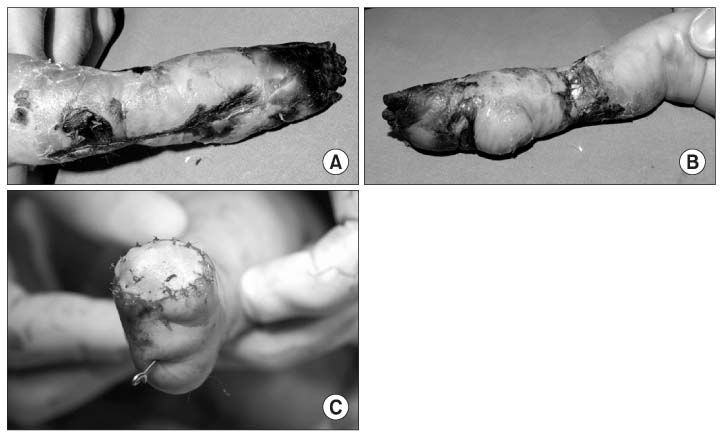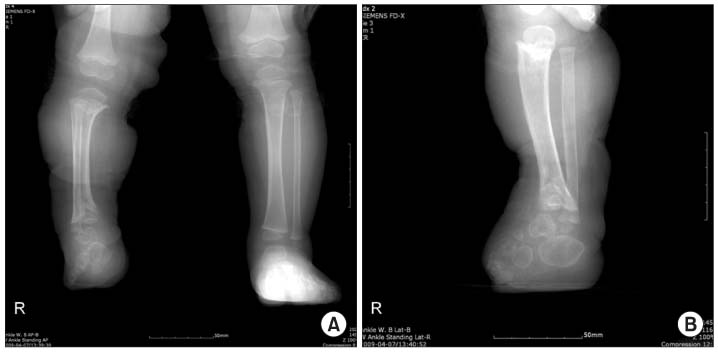J Korean Orthop Assoc.
2011 Aug;46(4):345-349. 10.4055/jkoa.2011.46.4.345.
Physeal Growth Arrest Caused by Thromboembolism of the Right Femoral Artery in a Premature Infant
- Affiliations
-
- 1Department of Orthopedic Surgery, Eulji University School of Medicine, Daejeon, Korea. hykim@eulji.ac.kr
- KMID: 2185434
- DOI: http://doi.org/10.4055/jkoa.2011.46.4.345
Abstract
- The known causes of premature physeal growth arrest are trauma, infection, tumor, antibiotics, radiation and vascular insult. We report here on a premature, very low birth-weight infant who was complicated with premature physeal arrest of the proximal and distal tibial physis after severe limb ischemia due to thromboembolism of the right femoral artery. This case suggests that a severe ischemic state of the lower extremity might cause premature physeal arrest in premature infants.
MeSH Terms
Figure
Reference
-
1. Martin JA, Kung HC, Mathews TJ, et al. Annual summary of vital statistics: 2006. Pediatrics. 2008. 121:788–801.
Article2. Merrer J, De Jonghe B, Golliot F, et al. French Catheter Study Group in Intensive Care. Complications of femoral and subclavian venous catheterization in critically ill patients: a randomized controlled trial. JAMA. 2001. 286:700–707.
Article3. National Institute of Child Health and Development (NICHD). Follow-up care of high-risk infants. Pediatrics. 2004. 114:1377–1397.4. Mactier H, Alroomi LG, Young DG, Raine PA. Central venous catheterisation in very low birthweight infants. Arch Dis Child. 1986. 61:449–453.
Article5. O'Neill JA Jr, Neblett WW 3rd, Born ML. Management of major thromboembolic complications of umbilical artery catheters. J Pediatr Surg. 1981. 16:972–978.6. Aspalter M, Domenig CM, Haumer M, Kitzmüller E, Kretschmer G, Hölzenbein TJ. Management of iatrogenic common femoral artery injuries in pediatric patients using primary vein patch angioplasty. J Pediatr Surg. 2007. 42:1898–1902.
Article7. Balaguru D, Dilawar M, Ruff P, Radtke WA. Early and late results of thrombolytic therapy using tissue-type plasminogen activator to restore arterial pulse after cardiac catheterization in infants and small children. Am J Cardiol. 2003. 91:908–910.
Article8. Lin PH, Dodson TF, Bush RL, et al. Surgical intervention for complications caused by femoral artery catheterization in pediatric patients. J Vasc Surg. 2001. 34:1071–1078.
Article9. Farrar MJ, Bennet GC, Wilson NI, Azmy A. The orthopaedic implications of peripheral limb ischaemia in infants and children. J Bone Joint Surg Br. 1996. 78:930–933.
Article10. Peterson HA. Premature physeal arrest of the distal tibia associated with temporary arterial insufficiency. J Pediatr Orthop. 1993. 13:672–675.
Article
- Full Text Links
- Actions
-
Cited
- CITED
-
- Close
- Share
- Similar articles
-
- Salter-Harris Type IV Physeal Fracture of the Distal Radius: A Case Report
- Experimental Study for the Effects of Free Physeal Transplantation to Regain Bone Grwoth after Partial Physeal Injury
- Physeal Growth Arrest by Excessive Compression: Histological, Biochemical, and Micro-CT Observations in Rabbits
- Prognostic Factors of Physeal Bar Resection and Fat Graft Interposition in the Treatment of Partial Physeal Arrest
- Physeal Remodeling after Internal Fixation of Slipped Capital Femoral Epiphysis





